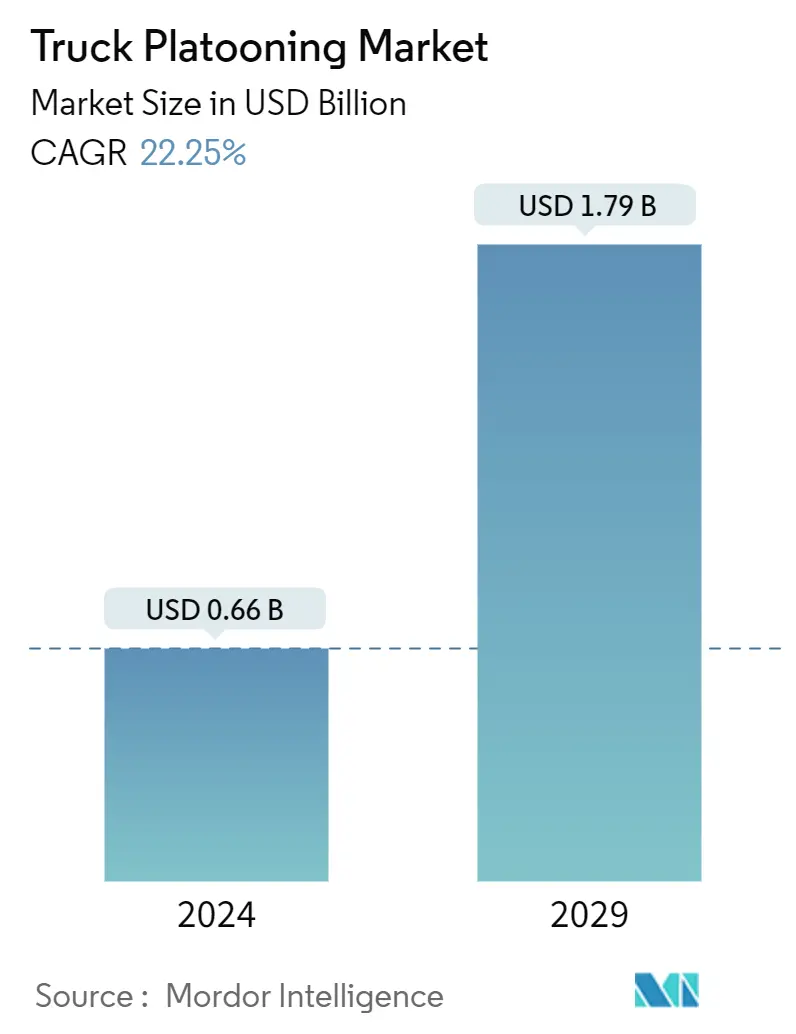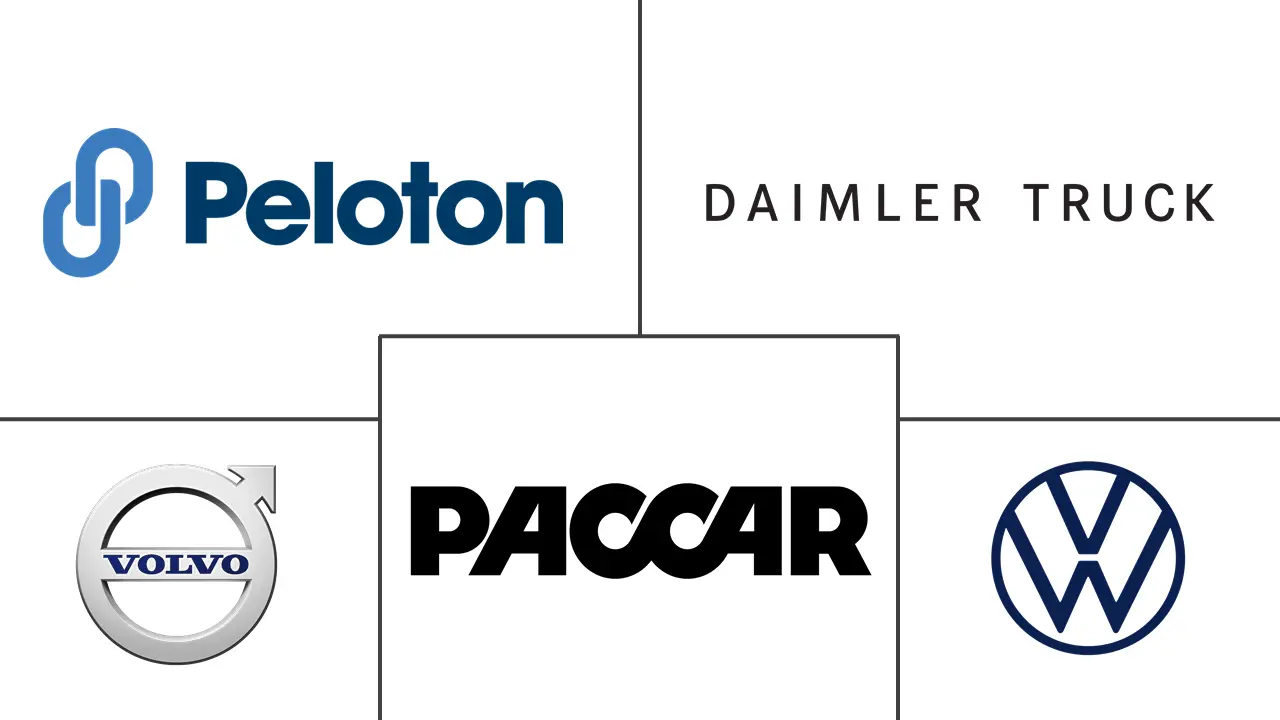Market Size of Truck Platooning Industry

| Study Period | 2019 - 2029 |
| Market Size (2024) | USD 0.66 Billion |
| Market Size (2029) | USD 1.79 Billion |
| CAGR (2024 - 2029) | 22.25 % |
| Fastest Growing Market | Europe |
| Largest Market | North America |
| Market Concentration | High |
Major Players
*Disclaimer: Major Players sorted in no particular order |
Truck Platooning Market Analysis
The Truck Platooning Market size is estimated at USD 0.66 billion in 2024, and is expected to reach USD 1.79 billion by 2029, growing at a CAGR of 22.25% during the forecast period (2024-2029).
Over the long term, the rise in the number of road accidents due to driver errors and increasing focus on reducing transportation operating costs are expected to fuel the demand in the truck platooning market. Truck platooning is expected to increase the demand in sectors such as road development, transportation, logistics, and information technology because of the rise in demand for automated technologies. The rising adoption of the Internet of Things (IoT) is another factor that will help the growth of the market over the forecast period. Moreover, governments worldwide are strategizing to implement guidelines to regulate the truck platooning industry, which is expected to positively contribute to the growth of the truck platooning market.
- Indiana and New York authorities in the United States proposed legislation to regulate the truck platooning industry. Indiana law authorizes automated vehicle platooning to operate “at speeds and following distances that are faster and closer than would be reasonable and prudent without electronic coordination.”. The New York state law has no requirements for large vehicles to have a human in the cab capable of taking control of the vehicle in case of emergency.
The market faces challenges due to the high costs associated with the adoption and implementation of the currently available technology. Truck platooning is a costly affair especially due to the high-end communication technology and infrastructure that are required to sustain this industry. However, the market is expected to witness steady growth due to the aggressive focus by the government to lower carbon emissions by reducing air-drag friction.
North America is expected to lead the truck platooning market globally, owing to the rapidly evolving autonomous vehicle technology and the growing concerns over safety in road transportation in the region. The European market is also projected to account for a significant revenue share in the truck platooning market, becoming the fastest-growing market during the forecast period.
Truck Platooning Industry Segmentation
Truck platooning refers to the linking of two or more trucks in a convoy using automated driving assistance systems and connectivity solutions between the vehicles. The vehicles in truck platooning maintain a close distance between them when they are connected for a certain part of the journey on roadways.
The truck platooning market is segmented by platooning type, technology type, infrastructure type, and geography. By platooning type, the market is segmented into driver-assistance truck platooning (DATP) and autonomous truck platooning. By technology type, the market is segmented into adaptive cruise control, forward collision warning, automated emergency braking, active brake assist, lane keep assist, and others (blind spot warning, etc.). By infrastructure type, the market is segmented into vehicle-to-vehicle (V2V), vehicle-to-infrastructure (V2I), and global positioning system (GPS). By geography, the market is segmented into North America, Europe, Asia-Pacific, and Rest of the World.
The report offers market size and forecasts for the truck platooning in value (USD) for all the above segments.
| By Platooning Type | |
| Driver-Assistive Truck Platooning (DATP) | |
| Autonomous Truck Platooning |
| By Technology Type | |
| Adaptive Cruise Control | |
| Forward Collision Warning | |
| Automated Emergency Braking | |
| Active Brake Assist | |
| Lane Keep Assist | |
| Others (Blind Spot Warning, etc.) |
| By Infrastructure Type | |
| Vehicle-to-Vehicle (V2V) | |
| Vehicle-to-Infrastructure (V2I) | |
| Global Positioning System (GPS) |
| By Geography | |||||||
| |||||||
| |||||||
| |||||||
|
Truck Platooning Market Size Summary
The truck platooning market is poised for significant growth over the forecast period, driven by the increasing need for automated technologies to enhance road safety and reduce transportation costs. The market is expected to expand as truck platooning gains traction in sectors such as logistics, transportation, and information technology. The adoption of the Internet of Things (IoT) and advancements in vehicle-to-vehicle (V2V) communication technologies are further propelling this growth. Government initiatives worldwide are also playing a crucial role by implementing regulations that support the development and deployment of truck platooning systems. Despite the high costs associated with the technology, the market is anticipated to grow steadily, supported by efforts to reduce carbon emissions and improve fuel efficiency.
North America is expected to lead the global truck platooning market, with Europe following closely due to its rapid advancements in autonomous vehicle technology and strong regulatory support. The European market is projected to be the fastest-growing, driven by significant investments in platooning technology and projects aimed at reducing traffic congestion and emissions. The adaptive cruise control segment is anticipated to experience the most rapid growth, as it is integral to the functionality of truck platooning systems. While the market is still in its early stages, major players like Peloton Technology, Daimler Truck AG, and AB Volvo are actively collaborating with governments and technology partners to advance their platooning solutions. These developments are expected to enhance the efficiency of cargo transportation and reduce the reliance on human drivers, thereby minimizing the risk of accidents caused by human error.
Truck Platooning Market Size - Table of Contents
-
1. MARKET DYNAMICS
-
1.1 Market Drivers
-
1.1.1 Governments' Aggressive Push Towards Lowering Fuel Consumption and Co2 Emission of Vehicles to Foster the Growth of the Market
-
-
1.2 Market Restraints
-
1.2.1 High Cost of Platooning Technology Deters Market Growth
-
-
1.3 Industry Attractiveness - Porter's Five Forces Analysis
-
1.3.1 Threat of New Entrants
-
1.3.2 Bargaining Power of Buyers/Consumers
-
1.3.3 Bargaining Power of Suppliers
-
1.3.4 Threat of Substitute Products
-
1.3.5 Intensity of Competitive Rivalry
-
-
-
2. MARKET SEGMENTATION (Market Size in Value - USD)
-
2.1 By Platooning Type
-
2.1.1 Driver-Assistive Truck Platooning (DATP)
-
2.1.2 Autonomous Truck Platooning
-
-
2.2 By Technology Type
-
2.2.1 Adaptive Cruise Control
-
2.2.2 Forward Collision Warning
-
2.2.3 Automated Emergency Braking
-
2.2.4 Active Brake Assist
-
2.2.5 Lane Keep Assist
-
2.2.6 Others (Blind Spot Warning, etc.)
-
-
2.3 By Infrastructure Type
-
2.3.1 Vehicle-to-Vehicle (V2V)
-
2.3.2 Vehicle-to-Infrastructure (V2I)
-
2.3.3 Global Positioning System (GPS)
-
-
2.4 By Geography
-
2.4.1 North America
-
2.4.1.1 United States
-
2.4.1.2 Canada
-
2.4.1.3 Rest of North America
-
-
2.4.2 Europe
-
2.4.2.1 Germany
-
2.4.2.2 United Kingdom
-
2.4.2.3 France
-
2.4.2.4 Spain
-
2.4.2.5 Rest of Europe
-
-
2.4.3 Asia Pacific
-
2.4.3.1 China
-
2.4.3.2 India
-
2.4.3.3 Japan
-
2.4.3.4 South Korea
-
2.4.3.5 Rest of Asia Pacific
-
-
2.4.4 Rest of the World
-
2.4.4.1 South America
-
2.4.4.2 Middle East and Africa
-
-
-
Truck Platooning Market Size FAQs
How big is the Truck Platooning Market?
The Truck Platooning Market size is expected to reach USD 0.66 billion in 2024 and grow at a CAGR of 22.25% to reach USD 1.79 billion by 2029.
What is the current Truck Platooning Market size?
In 2024, the Truck Platooning Market size is expected to reach USD 0.66 billion.

